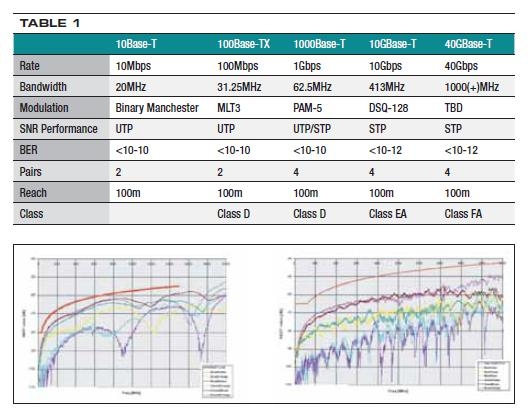The next level of copper cabling

Nobody has forgotten the endless discussions and steps involved with the development of 10Gbps over copper. There was a seemingly endless series of heated debates about the need, how it would work, power consumption, heat dissipation and of course the classic discussion of unshielded twisted pair (UTP) versus shield twisted pair (STP).
Today though, servers are being released with 10Gbps copper ports where the power consumption and heat dissipation has been reduced to an acceptable level. The cabling industry developed two new cabling classes – EA and FA – and acceptance for shielded systems has increased significantly.
ADVERTISEMENT
As the global demand for more speed and more data continues unabated, the Institute of Electrical and Electronics Engineers (IEEE) and a handful of cabling groups have started a project called ‘Next Generation Ethernet’, or in simpler terms ‘40Gbps over copper’.
The history
Over the past 15 years, each new application has required more bandwidth (see Table 1). This is based on fundamental technical factors that never change.
In 1995, 10Mbps was a common application along with token ring, asynchronous transfer mode (ATM) and analogue telephones. For those applications, a Category 3 cable was a sufficient media. With the introduction of 100Mbps fast Ethernet, a Class D/Cat 5 channel was required.
The key formula behind this is the Shannon capacity: C=B * log2 [ +1]. In this formula, C is the channel capacity in bits per second; B is the bandwidth of the channel in hertz; S is the total received signal power over the bandwidth; N is the total noise or interference power over the bandwidth; and S/N is the signal-to-noise ratio (SNR).
This is the maximum theoretical throughput (capacity) limit achievable for a communications channel. The channel capacity, expressed in ‘bps’ is dependent on the transmission media bandwidth (e.g. Class EA/Cat 6A, 500MHz or Class D/Cat 5, 100MHz) and the SNR of the channel. The SNR for 10Gbps is one of the key points and explains why shielded solutions deal much better with the application than UTP solutions.
Another key factor is the modulation or coding mechanism. This has changed with each generation of Ethernet. The goal here is to increase the number of bits per clock frequency. In simple terms, there are three parameters that influence the maximum transmission rate – bandwidth; modulation/ encoding; and SNR.
The future
During the October 2011 ISO/IEC meeting in Melbourne, there was a discussion on a 1,500-2,000MHz bandwidth requirement for 40Gbps on a 100m copper channel. There was no confirmation or acceptance of this bandwidth at the ISO/ IEC meeting because the IEEE has not yet confirmed the bandwidth required.
A technical analysis was presented to the ISO/IEC by German delegates, estimating cabling lengths for 40GBASE-T. T
he Shannon capacity was calculated for a two-connector channel length using Cat 6A and Cat 7A components. The lengths corresponding to 60Gbps Shannon capacity were as follows:
Cat 6A FTP, 500MHz, echo cancellation of 55db RL, 40db NEXT, 25dB FEXT – 0m.
Cat 6A FTP, 1000MHz, echo cancellation of 55db RL, 40db NEXT, 25dB FEXT – 2m
Cat 6A STP, 1600MHz, echo cancellation of 65db RL, 40db NEXT, 25dB FEXT – 55m.
Cat 7A STP, 1000MHz, echo cancellation of 65db RL, 20db NEXT, 10dB FEXT – 45m.
Cat 7A STP, 1600MHz, echo cancellation of 65db RL, 20dbNEXT, 10dB FEXT – 70m.
Cat 7A STP, 2000MHz, echo cancellation of 75db RL, 40db NEXT, 20dB FEXT – 90m.
Since 2002, some STP Class EA systems with headroom might now be able to support 40Gbps over short distances while the UTP technology has ended at this point. Figure 1 shows a system with a 2,000MHz channel performance based on the current definitions using a 1,500MHz S/FTP LSZH cable.
The current goals for 40Gbps over copper include:
100m distance.
Use of existing infrastructure.
10Gbps and 40Gbps with the same physical layer (PHY).
Multiple PHYs for higher speed with trunking.
802.3 Ethernet frame format.
Full duplex operation.
There have been already some investigations into the technical requirements for 40Gbps over copper.
In 2008, Pennsylvania State University released an analysis of the feasibility of 40Gbps over copper that concluded the principle feasibility of 40Gbps over a Cat 7A cable is a channel length of 50m, or 100Gbps with a 20m channel length.
Other investigations have found the same or similar results. As 40Gbps is initially a ‘data centre application’, the 50m channel length is well suited since typical copper lengths are less than 20m. It might even be possible that a 50m short distance application will be ratified by IEEE.
Commercial considerations
IT cabling can be used in several areas, by several customers and for several occasions. Systems with high bandwidth capabilities show their strength by having a long life cycle. This has to be considered during cost/lifetime comparisons.
Other important factors are the secondary costs, such as:
Cabling routing and installation.
Cabling certification.
Design rules and separation distances.
MICE environment.
The introduction of 10Gbps has shown the importance of those factors, particularly for UTP systems. With 40Gbps, or any other application higher than 10Gbps, those factors will become much more important than today, technically and cost-wise.
And what will be the effect on the cabling systems? At this stage the use of shielded systems with accurate and well-designed connectivity offer the best long term value. As the frequency range increases, little details are important such as good coupling attenuation and smart termination technology to avoid crosstalk as much as possible.
Conclusion
As with all other Ethernet standards, 40Gbps over copper is a process of iterations for both active and passive suppliers. In the near future there will be a recognised cabling solution and a customer demand. The time to start planning and installing the best cabling system is now.
Thorsten Punke is the A/NZ head of marketing for TE Connectivity’s Enterprise division. He has 13 years’ experience with a wide range of knowledge in copper, fibre, testing and active technology.
-
ADVERTISEMENT
-
ADVERTISEMENT

